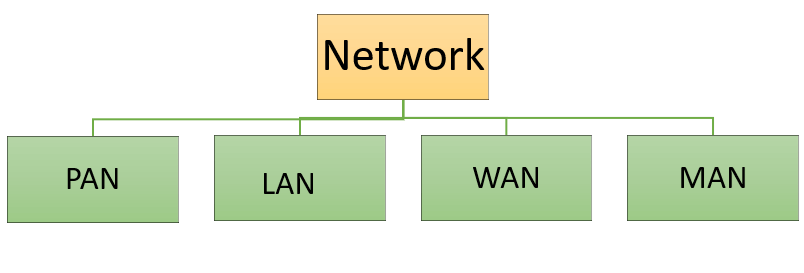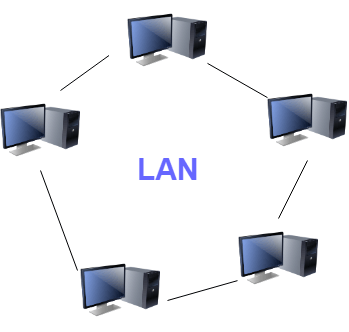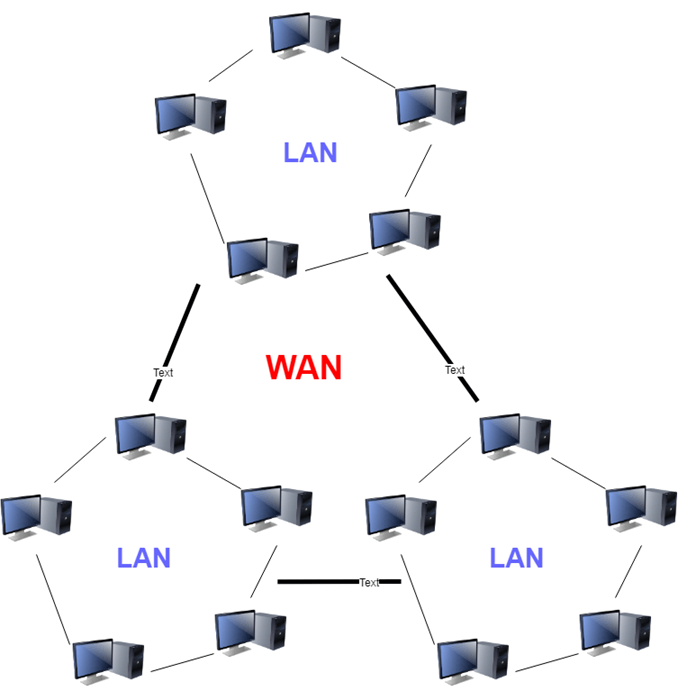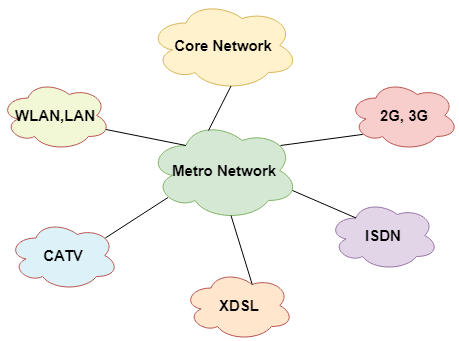Types of Computer Networks: LAN, MAN, WAN, VPN
There are various types of computer networks available. We can categorize them according to their size as well as their purpose.
The size of a network should be expressed by the geographic area and number of computers, which are a part of their networks. It includes devices housed in a single room to millions of devices spread across the world.

What is PAN (Personal Area Network)?
PAN is a computer network formed around a person. It generally consists of a computer, mobile, or personal digital assistant. PAN can be used for establishing communication among these personal devices for connecting to a digital network and the internet.
Characteristics of PAN
- It is mostly personal devices network equipped within a limited area.
- Allows you to handle the interconnection of IT devices at the surrounding of a single user.
- PAN includes mobile devices, tablet, and laptop.
- It can be wirelessly connected to the internet called WPAN.
- Appliances use for PAN: cordless mice, keyboards, and Bluetooth systems.
Advantages of PAN
- PAN networks are relatively secure and safe
- It offers only short-range solution up to ten meters
- Strictly restricted to a small area
Disadvantages of PAN
- It may establish a bad connection to other networks at the same radio bands.
- Distance limits.
What is LAN?

A Local Area Network (LAN) is a group of computer and peripheral devices which are connected in a limited area such as school, laboratory, home, and office building. It is a widely useful network for sharing resources like files, printers, games, and other application. The simplest type of LAN network is to connect computers and a printer in someone's home or office. In general, LAN will be used as one type of transmission medium.
It is a network which consists of less than 5000 interconnected devices across several buildings.
Characteristics of LAN
- It is a private network, so an outside regulatory body never controls it.
- LAN operates at a relatively higher speed compared to other WAN systems.
- There are various kinds of media access control methods like token ring and ethernet.
Advantages of LAN
- Computer resources like hard-disks, DVD-ROM, and printers can share local area networks. This significantly reduces the cost of hardware purchases.
- You can use the same software over the network instead of purchasing the licensed software for each client in the network.
- Data of all network users can be stored on a single hard disk of the server computer.
- You can easily transfer data and messages over networked computers.
- It will be easy to manage data at only one place, which makes data more secure.
- Local Area Network offers the facility to share a single internet connection among all the LAN users.
Disadvantages of LAN
- LAN will indeed save cost because of shared computer resources, but the initial cost of installing Local Area Networks is quite high.
- The LAN admin can check personal data files of every LAN user, so it does not offer good privacy.
- Unauthorized users can access critical data of an organization in case LAN admin is not able to secure centralized data repository.
- Local Area Network requires a constant LAN administration as there are issues related to software setup and hardware failures
What is WAN?

WAN (Wide Area Network) is another important computer network that which is spread across a large geographical area. WAN network system could be a connection of a LAN which connects with other LAN's using telephone lines and radio waves. It is mostly limited to an enterprise or an organization. Characteristics of LAN:
- The software files will be shared among all the users; therefore, all can access to the latest files.
- Any organization can form its global integrated network using WAN.
Advantages of WAN
- WAN helps you to cover a larger geographical area. Therefore business offices situated at longer distances can easily communicate.
- Contains devices like mobile phones, laptop, tablet, computers, gaming consoles, etc.
- WLAN connections work using radio transmitters and receivers built into client devices.
Disadvantage of WAN
- The initial setup cost of investment is very high.
- It is difficult to maintain the WAN network. You need skilled technicians and network administrators.
- There are more errors and issues because of the wide coverage and the use of different technologies.
- It requires more time to resolve issues because of the involvement of multiple wired and wireless technologies.
- Offers lower security compared to other types of networks.
What is MAN?

A Metropolitan Area Network or MAN is consisting of a computer network across an entire city, college campus, or a small region. This type of network is large than a LAN, which is mostly limited to a single building or site. Depending upon the type of configuration, this type of network allows you to cover an area from several miles to tens of miles.
Characteristics of MAN
- It mostly covers towns and cities in a maximum 50 km range
- Mostly used medium is optical fibers, cables
- Data rates adequate for distributed computing applications.
Advantages of MAN
- It offers fast communication using high-speed carriers, like fiber optic cables.
- It provides excellent support for an extensive size network and greater access to WANs.
- The dual bus in MAN network provides support to transmit data in both directions concurrently.
- A MAN network mostly includes some areas of a city or an entire city.
Disadvantages of MAN
- You need more cable to establish MAN connection from one place to another.
- In MAN network it is tough to make the system secure from hackers
Other Types of Networks
Apart from above mentioned here, are some other important types of networks:
- WLAN (Wireless Local Area Network) helps you to link single or multiple devices using wireless communication within a limited area like home, school, or office building. It gives users an ability to move around within a local coverage area which may be connected to the network. Today most modern day's WLAN systems are based on IEEE 802.11 standards.
- A Storage Area Network (SAN) is a type of network which allows consolidated, block-level data storage. It is mainly used to make storage devices, like disk arrays, optical jukeboxes, and tape libraries.
- System Area Network is used for a local network. It offers high-speed connection in server-to-server and processor-to-processor applications. The computers connected on a SAN network operate as a single system at quite high speed.
- Passive Optical Local Area Network (POLAN) is a networking technology which helps you to integrate into structured cabling. It allows you to resolve the issues of supporting Ethernet protocols and network apps. POLAN allows you to use optical splitter which helps you to separate an optical signal from a single-mode optical fiber. It converts this single signal into multiple signals.
- A Home Area Network (HAN) is always built using two or more interconnected computers to form a local area network (LAN) within the home. For example, in the United States, about 15 million homes have more than one computer. This type of network helps computer owners to interconnect with multiple computers. This network allows sharing files, programs, printers, and other peripherals.
- Enterprise Private Network (EPN) networks are build and owned by businesses that want to securely connect numerous locations in order to share various computer resources.
- Campus Area Network (CAN) A Campus Area Network is made up of an interconnection of LANs within a specific geographical area. For example, a university campus can be linked with a variety of campus buildings to connect all the academic departments.
- A Virtual Private Network (VPN) is a private network which uses a public network to connect remote sites or users together. The VPN network uses “virtual” connections routed through the internet from the enterprise's private network or a third-party VPN service to the remote site. It is a free or paid service that keeps your web browsing secure and private over public WiFi hotspots.
Summary
- Type of computer networks can categorize according to their size as well as their purpose
- PAN is a computer network which generally consists of a computer, mobile, or personal digital assistant
- LAN ( local area network) is a group of computer and peripheral devices which are connected in a limited area
- WAN (Wide Area Network) is another important computer network that which is spread across a large geographical area
- A metropolitan area network or MAN is consisting of a computer network across an entire city, college campus, or a small region
- WLAN is a wireless local area network that helps you to link single or multiple devices using. It uses wireless communication within a limited area like home, school, or office building.
- SAN is a storage area network is a type of network which allows consolidated, block-level data storage
- System area network offers high-speed connection in server-to-server applications, storage area networks, and processor-to-processor applications
- POLAN is a networking technology which helps you to integrate into structured cabling
- Home network (HAN) is a always built using two or more interconnected computers to form a local area network (LAN) within the home
- Enterprise private network (EPN) networks are build and owned by businesses that want to securely connect various locations
- Campus area network (CAN) is made up of an interconnection of LANs in a specific geographical area
- A VPN is a private network which uses a public network to connect remote sites or users together
Discussion